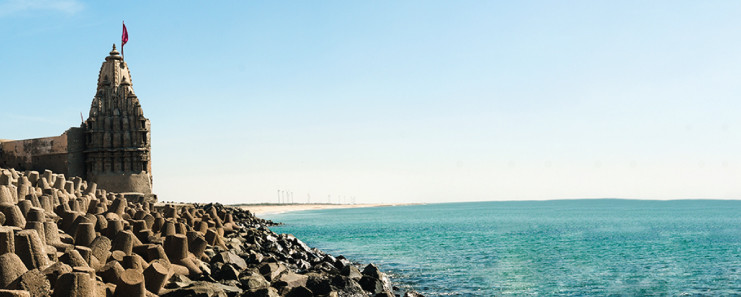Amazing facts about India.
Alexander commissioned an entire flotilla in India:
Greek accounts say that Alexander commissioned the building of an entire flotilla (1,800 ships) in India to carry back his retreating armies to Macedonia via the Gulf of Persia. Yes, Indians built ships for people from other lands.

The ship will still float, even if one part is shattered:
Nicole Dei Conti in 1420 CE wrote about his admiration for Indian skill in shipbuilding: “The native of India build some ships larger than ours, capable of containing 2,000 butts. Some ships are so built in compartments that should one part be shattered, the other portion remaining, the same may accomplish the voyage.”

They came to learn shipbuilding:
Indian shipbuilding technologies were studied and acquired by the famed Chinese Admiral Zheng He, who sent his famous chronicler and interpreter Ma Huan, to Bengal’s shipbuilding yards, during the Ming dynasty in the early 15th century (1400-1410 CE).
Offered models to Europeans:
F. Baltazar Salvyus, a Frenchman from 1811 CE noted: “In ancient times, the Indians excelled in the art of constructing vessels… can still offer models to Europe, so much so that the English, attentive to everything which relates to naval architecture, have borrowed many improvements from them which they have adopted with success to their own shipping.”
India was a navigational giant who reigned over the oceans of the world for millennia. For a stretch of 400 crucial years in world economics and history, (during the Renaissance period in Europe), West Asian civilizations and Europe looked up to India as a navigational giant.
Bharath Gyan, a passionate research initiative, is painstakingly dotting the pieces together, foraging amongst lost remnants to keep the glorious past alive and known. Here are some lesser-known facts:
A boost to trade
India had a 25 percent share in world trade before the British Rule. One of the secrets to India’s prosperity and resilience over the last few millennia was attributed to navigational and architectural skills to build the long distance, seaworthy ships and ports and harbors for trade around the globe.
With an 8,500 km-long coastline, and warm water throughout the year, India had maritime activity for thousands of years. From medieval times 5,000 years ago, India had well-developed ports and an extensive navigational system.
India had dominated the waters of the world and global trade scenario for millennia with her well-crafted ships, the huge volume of trade and with “naav (boat) the word for sea travel.
From Baluch and Sind in the West to East Bengal, India’s naval activity spanned at the very minimum from the east coast of Africa to South East Asian islands and beyond, even to the west coast of the Americas.
The father and son duo of Raja Raja Chola and Rajendra Chola of South India undertook many sea conquests towards the South East Asian islands. Between them and their immediate predecessors and successors, the Cholas dominated the maritime activity of the eastern seas for 200 years (between 850 CE and 1088 CE).
Trade with Egypt, Damascus, Tyre, Mesopotamia, Arabia, and Dilmun (modern Bahrain-Oman) flourished. In comparison, European naval activity, till about 1400s, was limited to the Mediterranean Sea and the east coast of the Atlantic Ocean.
Indian ships led Vasco da Gama
Vasco da Gama, the Portuguese explorer, sailed in the largest ships of his times, the 28-meter-long Sao Gabriel.
Vasco da Gama reached India sailing around Africa in 1497 and is credited with having found the sea route to India. He travelled down the Atlantic Ocean from Cape Verde to the Cape of Good Hope in South Africa.
He wrote in his logbook diary, which is now in the Lisbon Maritime Museum that when he came to South Africa, he saw Indian ships ten times the size of his own ship.
Ship name | Country | Length |
| Santa Maria (belonged to Christopher Columbus) | America | Over 20 meters |
| Sao Gabriel (Vasco da Gama) | Portugal | Over 30 meters |
| Gamini | India | 50 meters |
| Tari | India | 60 meters |
| Janghala | India | Over 60 meters |
| Plavini | India | Over 70 meters |
| Dharini | India | 80 meters |
| Begini | India | Almost 90 meters |
Then, when faced with the daunting challenge of having to travel in the Indian Ocean waters towards India, he saw large Indian ships travelling back to India from the east coast of Africa. It was in the midst of these Indian ships that Vasco da Gama travelled mid seas to India.
These ships guided him to the Malabar coast of India and landed in Kozhikode, later called Calicut by the colonial writers. There, he paid his respects to the local king referred to as Samuthirai, meaning one who is the king of the seas. Samudra is seas and Rai or Raja is king.
Isn’t our cultural heritage fascinating? Equally intriguing is our tradition of healing and health. Thousands of years ago, our ancient sages unlocked techniques and wisdom to maintain holistic health. Know more about these secrets at The Art of Living Meditation and Breath Program.
Discover India's spiritual heritage and learn about the mind & breath. I'd like to know more>>
What is missed out is that Vasco da Gama had indeed found the sea route to India but for the Europeans. Indians had been plying these seas much earlier, and thus guided him to India.

The ancient science of shipbuilding
Our Vedas mention Varuna as the divinity for waters and seas. The slogan of the Indian Navy even today is Shanoh Varunaha.
The ship sizes mentioned in the Nava Shastra, the Indian navigational text, states that India had huge ships, and had industries that built such ships. The ancient Indians were far advanced in their understanding of this science.
Robert Heine Geldern and Gordon F. Ekholm, anthropologists studying the civilizations of ancient Americas, state:
“Ships of size that carried Fahien from India to China (through stormy China water) were certainly capable of proceeding all the way to Mexico and Peru by crossing the Pacific.
One thousand years before the birth of Columbus, Indian ships were far superior to any made in Europe up to the 18th century.”
By the 11th century, Raja Bhoja instituted shipbuilding as a systematic science. In the same period, no country in Europe had textual information on shipbuilding.
Lothal – a model port
Lothal in Gujarat was one of the oldest ports in the world dating from 3700 BC. Discovered in 1954, this port has been identified as an inland dockyard, fully equipped to berth and service ships.
Archaeologists and oceanographers have concluded that ancient Indians must have had great knowledge relating to tides, to build such a dock on the ever-changing course of the Sabarmati river.

The port area had warehouses to stock goods, markets for displaying wares for trade as well as administrative and some resting quarters.
It served as, both, a seafaring port as well as a harbor for inland traffic to carry the goods between the port and the hinterland.
The similarity of anchors and other artefacts found at Lothal, Dwaraka and other ancient ports of India with those found in Arabia, Sumeria, Mesopotomia and Phoenicia prove that a 5,000-year-old trade flourished.
“First arrival into bay, founds more ships by 500 than we did, most of them transported their commodities to the Red Sea, along the coasts; or the Gulf of Persia and thence, they were carried overland to Scandaroon, Aleppo or Constantinople, up to the hands of the Venetians.”
What Dr. Fryer was conveying was the sea trade routes from India all the way to Europe which had sustained trade between India and Arabia, Egypt, Persia, Turkey, Greece and Rome for millennia.
Dwaraka – a gateway of India
The very name Dwaraka for the foremost ancient port of India, which sank over 5,100 years ago and lies undersea today, means Gateway.
Dwaraka was the gateway to India for trade. Built by the legendary Yadava, Krishna, and his people, who can be dated to 3100 BCE, gives this port an antiquity of 5,100 years.
The people of Dwaraka had innovated the technique of cutting through natural rock and using it to serve the purposes of a harbor such as berthing, very early, around 5,000 years ago as evidenced in the neighboring port of Lothal too.
* “India excelled in dry dock construction. The dry dock in Bombay has no comparison in the whole of Europe with regard to the size or excellence.”
* “Ships built at Bombay were executed 1/4th cheaper than in the docks of England.”
Close to 400 ships were built in the Bombay shipyards alone.
These well designed, stone cut harbors of India were copied by the Phoenicians, acknowledged as the pioneer seafarers of the world by Europe.
Not only for trade, India’s naval force helped guard Indian waters from foreign invaders. The Marathas created a formidable navy under the able leadership of Kanhoji Angre, and helped guard the Konkan coast for nearly a century and kept the colonial powers at bay. The colonial powers could only function as minor trading posts in the Konkan coast.
Thus, while the ancient West Asian civilizations went under, one by one, the Indian civilization continued and its prowess in navigation also continued until the 1700s, establishing it as a naval giant for many millennia.
The material has been sourced from @bharathgyan. This research team, led by a passionate husband-wife duo - Dr. DK Hari and Dr. Hema Hari, unearth some of India’s untold stories and make them contemporary. You can click here to buy any of their books on Indian civilization.































